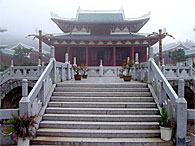|
Later History: are the Five Ancestors the same as the Five Elders? |
|
This question takes us a few hundred years further on from the Age of Bai Yufeng and the creation and establishment of the art of Wuzuquan. These centuries (which comprised those of the Ming Dynasty and earlier phase of the Qing Dynasty – in which more generally the major school systems of Baguazhang, Xinyiquan, and Taijiquan were born) witnessed the refinement of the system under inspired great teachers and guardians of the lineage.
With the Manchu conquest of China, and under their rulers (The Qing Dynasty 1644-1912) the Shaolin Temple at Henan was destroyed – for politically self-evident reasons of self-preservation.
|
|
|
Not a few of the monks who survived the destruction of the Temple made their way to the south-eastern Province of Fujian: a land that was even then regarded as ‘frontier territory,’ largely uncivilised and comprised of rough terrain – ideal for brigands, and also for rebels. Due to these factors and favourable circumstances those Shaolin monks who sought refuge there established the greatly renowned Southern Shaolin Temple in the province, spreading their teachings and skills to the peoples of Quanzhou and Putian. At this temple Shaolin Gong Fu flourished greatly, but as at the original Shaolin Temple at Song Mountain in Henan, the Fighting Monks – ever the most staunch and effective opponents of the Manchu enemy, and sharpened still more by their success in fighting the Japanese pirates who infested the province’s coastlands – of the Southern Shaolin Temple found themselves both feared and hated by the ruling dynasty.
|
|
|
On a time that dynasty sent overwhelming force to Fujian to destroy the temple and kill or take prisoner its monks. In this way the Southern Shaolin Temple was destroyed, and its monks forced to flee (two, of particular renown, were Chei-San and Ching-Tsao; these two escaping to Kwantung) far and wide, including overseas: it was due to these events that Wuzuquan came to be established in many lands of South East Asia by the Fujianese monks of the Southern Shaolin Temple.
However, five monks survived the ferocious onslaught, and it is these five, known as THE FIVE ELDERS who enabled the FIVE ANCESTOR SYSTEM, founded many centuries earlier, to survive and be passed to future generations.
The Five Elders were: Zhi Shan Chan Shi (Jee Sin); Wu Mei Da Shi (Ng Mui); Bai Mei Dao Ren (Bak Mei) ‘White Eyebrow’; Feng Daode (Fung Do-Duk); Miao Xian (Miu Hin).
|
|
Were the Five Elders responsible for establishing the five major styles of southern martial arts?
No, they were not directly responsible for the creation of those Styles, however five of the most well-known students of one of the Five Elders - Zhi Shan Chan Shi (Jee Sin) - were the founders of these famous Southern Styles.
Hung Gar was founded by Hong Xiguan; Lau Gar, by Liu Sanyan; Choy Gar, by Cai Jiuyi; Lee Gar, by Li Youshan (teacher of Choy Lee Fut Founder, Chan Heung); and Mok Gar, by Mo Qingjiao.
|
|
|
The continuation of the FIVE ANCESTOR SYSTEM due to the survival by the FIVE ELDERS of the destruction of the Southern Shaolin Temple was thereafter achieved through great secrecy: these great grandmasters passing the art on to their disciples, and they to theirs for many generations, by utmost discretion.
It was during this period that code words became the lingua-franca of masters and disciples to preserve the transference of knowledge of the arts, and still more training in those arts, from the ever vigilant eyes of the Manchu/Qing Dynasty rulers and their spies.
This is the origin of the code phrase, ‘have you had your midnight porridge [congee],’ used by Gong Fu masters and disciples to protect themselves from betrayal: a phrase which paints a very vivid picture of their lifestyle as Gong Fu practitioners – almost all training, learning, and teaching of these forbidden arts having to take place late at night to avoid discovery.
The arts and lineage survived in this fashion for generations, up to the demise of the Qing Dynasty and establishment of the Republic of China under Dr Sun Yat Sen in 1911/12. It is universally acknowledged that Grandmaster Chee Kim Thong of Putian in Fujian, due to the exemplary pedigree of the lineage of his masters was the chief guardian and preserver of the system in its true, most pure form.
|
|
|
It is important to note, on the topic of secrecy and dissimulation necessary for the preservation of the lives of practitioners (and of the lineage and even of proper/accurate knowledge of the System itself) in those dark days – made all the more dark as the Qing Dynasty slowly decayed and its rulers became ever more fearful of potential challengers – that for those practitioners [of the arts] who were surprised or captured, a variety of explanations were provided to protect their Gong Fu brothers, and above all their Masters/Teachers, from exposure and capture.
In some cases the unlucky prisoners would claim that they had been taught their fighting techniques by the gods, and in others it would be claimed that they themselves had been responsible for inventing the fighting systems they practised. This last device, while employed in the circumstances of that age is one of the reasons for setting a precedent which in our own post 1949 age has been wantonly and basely abused by many of inferior ability.
|
|
